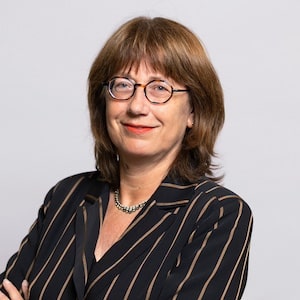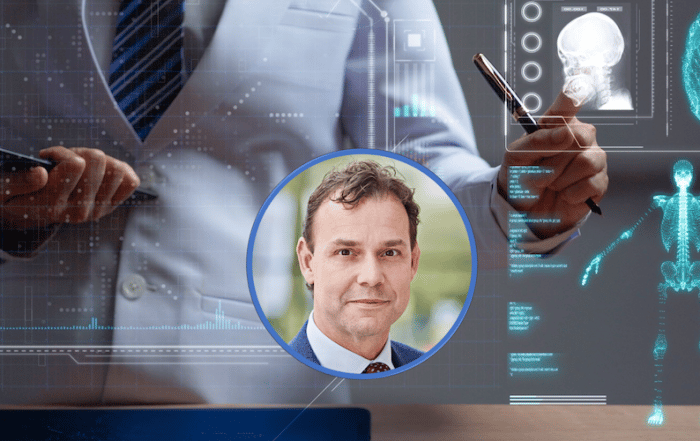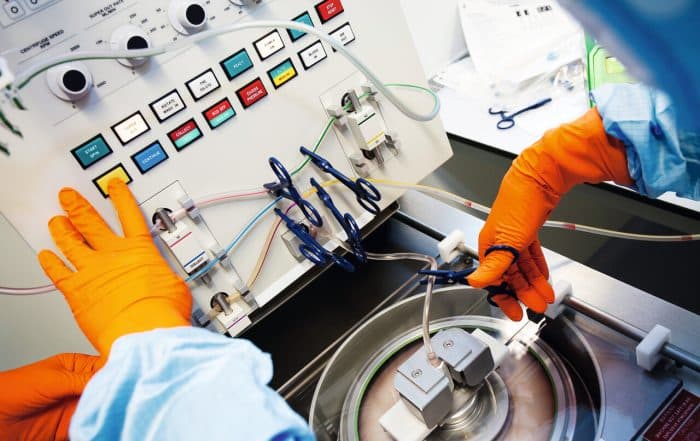Davide Iannuzzi helps academics make an impact
Ensuring that the university uses its research results for the benefit of society. That is the mission of Davide Iannuzzi, the new Chief Impact Officer of the VU. And also: “Helping entrepreneurial academics become academic entrepreneurs”.
“As a university, we don’t want to be an ivory tower,” says Iannuzzi. “We want to collaborate with citizens, politicians and companies. Responding to the needs of society and co-creating knowledge.” Making a proactive contribution to society is what drives the collaboration between the VU and our Smart Health Amsterdam initiative. “We want to ensure that Amsterdam can develop in a way that is better for citizens,” says Iannuzzi. According to him, the Smart Health Amsterdam ecosystem offers opportunities to “make the city more liveable and to co-create with the city and beyond.”
Valorisation strategy
Iannuzzi is a professor of physics at the VU and became Chief Impact Officer at the beginning of 2022. The position was created to strengthen valorisation and entrepreneurship within the university. Valorisation is about the practical use of knowledge gained in research. For example for social purposes, such as sharing knowledge with a wide audience. Or in collaboration with governments. Or for economic purposes, such as setting up start-ups and obtaining patents. The goal of Iannuzzi’s position is “to bring about a culture change that makes valorisation as important as the other two missions of the university – research and education.”
VU Amsterdam has set up a strategic valorisation structure university-wide, with a responsible person within each faculty. “I’m just the end point,” says Iannuzzi. “My role is to make sure that things work well here at VU, that we have a good strategy that enables researchers to bring about change. It is also an externally oriented role, with which we seize the opportunities we have and create good relationships with our environment and collaborate with, for example, the University of Amsterdam and the Amsterdam University of Applied Sciences.”
Article continues below the image

Davide Iannuzzi, Chief Impact Officer and professor of physics, Vrije Universiteit
Creating the right values for impact
Iannuzzi aims to create the right conditions for academics to make an impact and has clear ideas about how to do that. Researchers must be supported and made to feel welcome and there must be coherent policies in place to reward those working on valorisation activities. “I strongly believe that behaviour follows structure. If you want to change how people behave, if you want a real cultural change, you need to put the right structures in place.”
This includes truly putting valorisation on a par with research and teaching. “You cannot punish a person because they’re doing valorisation and thus doing less research and teaching. If we really want to make sure valorisation is at the same level as research and teaching, then we must make sure that we reward people who are focusing on valorisation. There is a lot of discussion of this at the moment, and a move towards changing the way we evaluate researchers.”
Money troubles
But the deeper issue, he says, is “the fact that valorisation costs money.” There are very few universities in the world that make more than they spend on valorisation and insisting on a return for investment is not going to work. “Universities create value,” says Iannuzzi, “then investors and entrepreneurs add value to that. But the value is captured only at the end of the valorisation process, and the university doesn’t see a lot of this value. And I don’t only mean the financial value, but also the number of jobs created, the new technologies created, the brains that are attracted to the Netherlands and so on. Research and teaching are subsidised by the state. Valorisation is largely not.”
Sharing the risk
The Dutch government has a role to play, says Iannuzzi. “We must sit at a table and understand as a country that the return-on-investment loop doesn’t close at the university itself.” Ensuring that universities receive enough funding to support valorisation activities is a logical next step.” It’s important, too, that investors share the risks when entering public/private partnerships.
Birth of the Demonstrator Lab
Iannuzzi’s own entrepreneurial career began in 2006, when he patented an idea based on the application of one of his own inventions. After five years of research and development, he launched his company in 2011. Researchers and academics then began coming to him for advice on how to take their work to market. “The questions were all the same. So I asked myself, how can we systematically support researchers in this process?” The answer to this question was the launch of the VU’s Demonstrator Lab in 2016, a space where, according to the website, ‘entrepreneurial academics become academic entrepreneurs’.
Playground for students and researchers
The Lab supports people who want to transform an idea into a tangible product or service and is a resource not only for the VU but also for other Smart Health partners: AUAS, the University of Amsterdam and Amsterdam UMC. Iannuzzi describes it as “a sort of playground where students, researchers and staff can play the entrepreneurship game and see if they like it or not at a very early phase.” The Lab offers facilities where people can test their ideas, build prototypes and connect with potential collaborators. Iannuzzi stresses that the bar to participation is set extremely low: “Almost everyone can enter, as long as they have an idea that is not in contradiction with science.” More than 100 different projects have made use of the Lab so far, and 22 of them are now registered companies.
Successes…
Successful ideas to emerge from the Lab range from a punching bag that gives feedback to athletes on their performance and an AI algorithm that scouts for new technologies to solve commercial companies’ problems. Iannuzzi is also enthusiastic about a new healthcare solution that has made it out of the Lab and into hospitals. Created by a VU researcher, the innovation uses second and third harmonic imaging to investigate and analyse biological tissues. The instrument is placed in the operating room so when a surgeon removes suspicious tissue it can be examined immediately rather than having to be sent to a pathology laboratory for analysis. “They can make a good assessment of the tissue on the spot,” he explains,” because it’s an extremely fast technique and very high resolution. So instead of closing the patient and waiting, the surgeon can look immediately at what has been removed and decide what to do next right away.”
…and failures
The Demonstrator Lab is an educational space for both students and researcher to learn about entrepreneurship, and failure is inevitable for many projects. According to Iannuzzi, it comes with the territory. “Maybe you fail the first time and succeed the second, or maybe you also fail the second time and succeed the third. This is not a problem.” He believes there are two main obstacles to success. The first is the failure to understand that an idea and a product are two different things. “Students are more flexible in this,” he says, “but a lot of researchers come in and say, well, my idea is perfect. Everyone will buy it. And that’s wrong. It’s not going to happen. The idea is maybe 10% of the success. The way in which you bring that idea to market makes the difference.”
The second obstacle is the make-up of the team working on an idea. Iannuzzi acknowledges that this can be seen as a clichéd opinion but is adamant that it’s the case. “You start with the enthusiasm of a group of friends, and then when things start to go not very well, the team breaks apart. Having a well-balanced team that is resilient is fundamental to success.” Luck and timing also play a part and Iannuzzi warns that many people underestimate just how difficult it is to achieve entrepreneurial success. “We see these examples of students who get excited, they’ve done something in their garage and they come to us very enthusiastic. But then it gets harder, and they have to speed up and spend more time developing their idea.” One student, he recalls, gave up on their project because they wanted to go on holiday.
Creating an entrepreneurship funnel
Iannuzzi pictures the Demonstrator Lab as the first step in a path leading from academia to what he describes as “the cliff of the valley of death” – the point where innovators must take the plunge into a tougher, more competitive environment. He stresses the importance of an integrated funnel that can support budding entrepreneurs on the journey from idea to product. He cites initiatives such as the AUAS 10K programme, the ACE Accelerator as well as the VU’s own Startup Hub and the UvA’s Startup Village as examples. Iannuzzi is a keen advocate for more collaboration between universities, funders and others to create this entrepreneurship funnel, something the Smart Health Amsterdam ecosystem supports. “We are creating pieces of the puzzle and putting the pieces together, and Smart Health Amsterdam is certainly a piece of the puzzle, to help us co-create and connect with each other.”
14 July 2022
Read more about
Contact us
Want to keep up to date?
Get the best regional news and events (in Dutch) via the Board Update newsletter
Share this news
Want to keep informed?
Follow us daily on LinkedIn and sign up for the Board Update newsletter.
Read more
- Focusing more on women in health care innovation and research will have ...
- What is the Amsterdam Metropolitan Area’s position on critical raw materials? ...
- Preparations for the National Zorginnovatieprijs 2026 by Zorginnovatie.nl are underway, and registration ...




